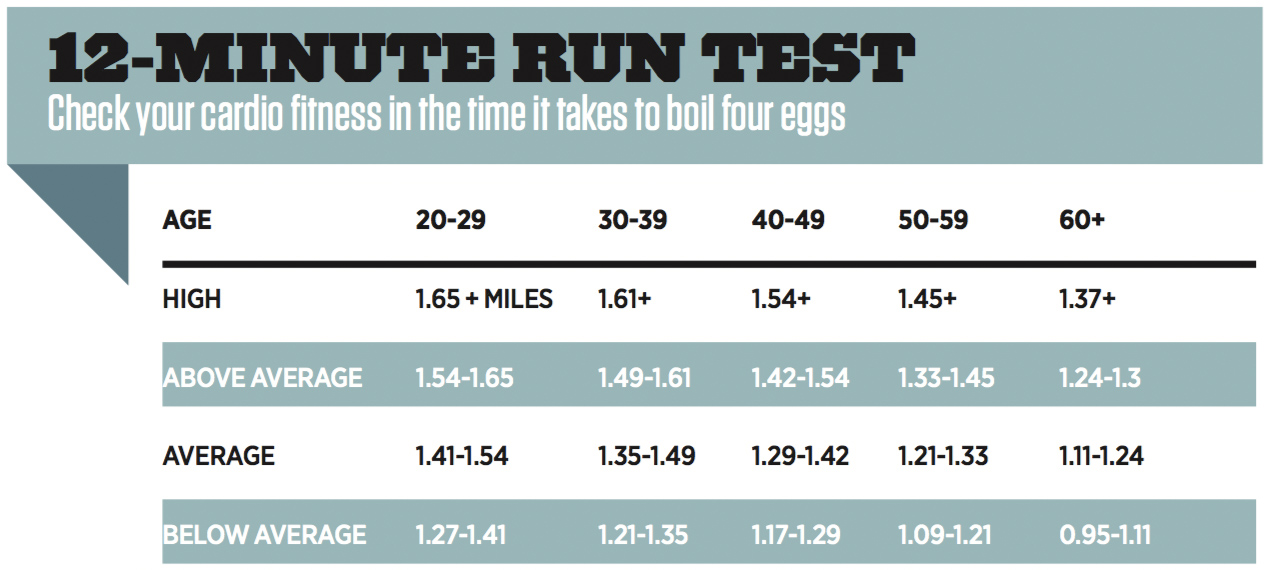
You’ve bought a fancy new pair of trainers, read Men’s Running from cover to cover and cut down on booze at the weekends. Now you’re ready to pound the pavements for the first time, right?
Not quite. For any beginner, it is important to establish your base level of fitness and then monitor the progression in your performance against a set of agreed goals. Here are five easy-to- administer tests for the novice runner:
1. Resting heart test
Your resting heart rate is directly affected by your fitness level as well as age. Generally speaking, the fitter you are, the lower your resting heart rate. If you test yourself regularly, it can be used as an indication of progress.
The best time would be first thing in the morning when you have just woken up. Place your middle and index fingers lightly on the underside of the opposite wrist, just below the base of the thumb until you can feel the pulse. Keep count of the beats over a 60 second period.
Take the reading over three consecutive days to give an average.
2. 12-minute run test
Ideally this test should be administered on a running track, but failing that, a treadmill works as well. The idea is to travel as far as possible in 12 minutes (it’s okay to walk if you are building up to running.)
When the 12 minutes are up, stop immediately (but safely) and measure the distance you have travelled. If you are on a track you will need to count the laps (normally 400 metres) then measure any extra distance you have travelled beyond the start line.

3. Side-jump test
Place three strips of tape parallel to each other on the floor with a 30cm gap between them. Make sure the surface is flat and even with good grip. Stand on the middle line then jump with both feet to the line on the right; then back to the middle; then repeat to the left line. Count this as one complete repetition.
Perform as many repetitions as you can in one minute. A score of between 38-45 is average, 46-49 good and 50 and above, very good.
4. Squat test
This squat test is easy to perform and measures the muscular endurance of the legs, concentrating on the quads, hamstrings and glutes. As with all strength tests, it is important to maintain perfect form.
Stand in front of a chair, as if about to sit down. Place your hands on your hips with your feet shoulder-width apart. Lower yourself down to the chair until your backside just touches the seat, then return to the starting position.
Make sure you keep your shoulders back, and your lower back straight. Repeat the movement keeping count of the number of squats performed.
It is important to maintain a regular rhythm because the test ends when you are unable to maintain your speed. It is useful to download a metronome application to your phone. You can use this to dictate your tempo.
Repeat every four to six weeks to monitor progress. Depending upon your age and ability, a score of over 40 would be good while fewer than 25 and you should consider doing some resistance work on the lower body.
5. Flexibility test
While full body flexibility is important for all sports, runners will concentrate particularly on the legs.
To test your hamstrings, lie on the floor on your back and place one hand on your right leg to hold it down and keep the pelvis stable. Raise the other leg in the air ensuring to kept it perfectly straight at all times. Raise the leg as far as is comfortable without bending the knee or moving the pelvis.
If you can raise the leg to approximately 90 degrees, then your hamstring flexibility is good; below 80 degrees is poor and you should work on this area.
To test your hip flexors, you may need to enlist the help of a friend to observe your position. Lie on the floor on your back as before. Grab hold of the back of the right thigh and bring the knee up towards the chest.
If your extended leg remains flat and the hips have not tilted then there is a good level of flexibility in this area. If the leg bends at the knee and the hips tilt when the knee is brought up then, you may have some tightness through the hip flexors.
It is important you consult your GP to seek advice before attempting any fitness tests.






